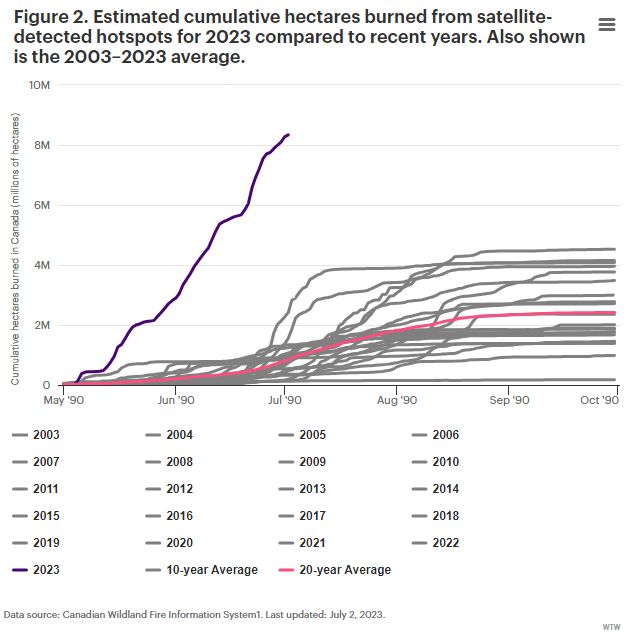Canada's 2023 wildfire season is officially its worst on record, the total burned area has surpassed 8.33 million hectares, breaking the previous record for the largest area burned in a single year.
Unprecedented Magnitude
Canada's 2023 wildfire season made history on June 30, by surpassing the previous record of 8.02 million hectares of burned area in a single season, set in 1989 (Figure 1). This area was reached after only 60 days of the May-September fire season, which is in stark contrast to 1989, which took 153 days to reach the same area of destruction.
Canada's 2023 wildfire season made history on June 30, by surpassing the previous record of 8.02 million hectares of burned area in a single season.
These wildfires have affected nearly every province and territory in Canada, with only Prince Edward Island and Nunavut being spared. Out of the numerous wildfires, just four fires account for one-quarter of the total burned area reported so far1. In fact, the combined area (2.35 million hectares) affected by these four fires exceeds the total burned area recorded at the end of the fire season in 46 out of the past 64 years. Notably, the Donnie Creek fire in British Columbia, the second largest among these four fires, has become the largest fire ever recorded in the province, spanning an area of 571,000 hectares1.

While the fires are predominantly occurring in remote areas, and Canada has had large fires in the past2, the timing and widespread nature of the burning this year is highly unusual. The scale of this year's fires is so large that the burned area as of July 2 (8.33 million hectares) is equivalent in size to countries such as Czechia and Austria (Figure 2).
Unusual Characteristics
When looking at historical daily data from the Canadian Wildland Fire Information System for the last 20 years (2003-2023)1, the unusual characteristics of the current wildfires are clear. The burned area (Figure 2), number (Figure 3), and location (Figure 4) of the fires have all deviated from previous years, making 2023 unparalleled in recent history.
One striking aspect is the early onset of the burning, which caught many by surprise as it occurred before the usual favorable weather conditions for widespread blazes3
Figure 2 and Figure 3 illustrate how the fires started much earlier than in previous years, with May 2023 experiencing a record-breaking number of nearly 70,000 individually detected hotspots. The burned area at the end of May this year - amounting to 2.8 million hectares - is larger than the end of May burned area for all years combined over the last decade (2012-2022). On May 5 alone, the burned area witnessed a six fold increase compared to the previous day, highlighting the rapid rate of spread.
Furthermore, over 520,000 hectares were burned in a single day, marking the highest daily total in the available data. The current wildfires' extent exceeds the 20-year average for this time of year by a factor of ten.
The current wildfires' extent exceeds the 20-year average for this time of year by a factor of ten.
What Sparked the Early Onset?
The early start to the season can be attributed, in part, to the record-breaking heat experienced across western Canada in May4. This comes against a backdrop of rising temperatures across all seasons in the country over the last few decades5.
The particularly hot and dry weather this year created a conducive environment for fire ignition and rapid wildfire spread.
This year is not an isolated event, but part of a larger trend observed in Canada, and across the world.
Human-caused fires, which are often smaller in scale, are also happening more frequently during the transitional seasons.
Western Canada, in particular, has experienced a noticeable increase in both the size of burned areas and the frequency of large fires since the 1960s, often sparked by lightning strikes2. Human-caused fires, which are often smaller in scale, are also happening more frequently during the transitional seasons, which have been extended due to earlier springs and later winters. These shifts in the fire season coincide with periods when vegetation becomes highly flammable due to reduced water content, the shedding of leaves from deciduous trees, and increased curing. These factors, together with the effects of climate change, are projected to exacerbate fire activity throughout Canada by the end of the century2.

Figure 4. The proportion of the total burned area by province/territory, as of July 2, 2023 (bottom) compared to the 20-year (2003-2022) average (top) for the same time period.
Source: Canadian Wildland Fire Information System1. Last updated: July 2, 2023
Beyond the Flames
The 2023 season has presented challenges for firefighters and emergency responders. The fires have varied in size, number, and location, making it exceptionally difficult to combat them. Consequently, evacuations have been necessary, and as of July 2, over 600 structures have been damaged or destroyed. Even regions not directly threatened have been impacted as smoke drifts across North America. This resulted in deteriorated air quality conditions during early June, particularly in major cities like Boston, New York City, Philadelphia, and Washington, D.C.
By the end of June, the smoke from the wildfires had traveled across the Atlantic Ocean, reaching as far as central and south-eastern England, as well as western Scotland, as observed by satellites6. Fortunately, there have been no reported fatalities.
It is worth noting that while comparing the current wildfires to the devastating McMurray fires in 2016, which hold the record for the worst insured natural catastrophe loss in Canadian history, we must acknowledge that we are still in the midst of the wildfire season, and the final outcome remains uncertain. So far, the majority of the burning has occurred in remote areas, away from densely populated regions, allowing some to naturally extinguish to a certain extent. Consequently, the impact on cities, towns, and properties has been relatively limited.
Nevertheless, the wildfires have already affected multiple sectors of the economy. Tourism has declined due to concerns about air quality and safety issues. This has led to a decrease in visits and the closure of businesses in some regions7. Furthermore, the forestry sector has been significantly impacted, with sawmills forced to close8. This disruption in the wood product supply chain has temporarily boosted lumber prices due to dwindling supplies and rising demand.
Despite limited property damage so far, the repercussions of the wildfires are expected to reverberate in the insurance industry. Insurers will likely reassess their policies and pricing as concerns mount over more frequent and severe events in response to climate change. Property owners in wildfire-prone areas may face higher insurance costs due to the combined risks associated with climate change and inflationary pressures.
Looking Ahead: The Lingering Threat
As we move forward through the summer, the lingering threat of wildfires will continue to loom large. Although the peak of El Niño (see Section 3.1) is unlikely to coincide with the current fire year, the approaching summer months bring the potential for more extreme heat and dry weather, which are primers for further fire activity. With the Canadian wildfire season extending until the end of September, a pressing question arises: just how far will this year's wildfires spread? Only time will reveal the true extent of the environmental and socioeconomic impacts.
Footnotes
1. Canadian Wildland Fire Information System. (2023).
2. Hanes, C. C. et al. Fire-regime changes in Canada over the last half century. Canadian Journal of Forest Research 49, 256-269 (2019).
3. Owens, B. Why are the Canadian wildfires so bad this year? Nature News. (2023).
4. Summer temperatures arrive early. NASA. (2023).
5. Environment and Climate Change Canada. Government of Canada. (2023).
6. Russell, R. Satellite images show Canadian wildfire smoke over UK. BBC. (2023).
7. Blake, E. Wildfires Impact Tourism in Canada. Financial Post. (2023).
8. Nickel, R. Analysis: Canadian wildfires shutter sawmills, drive up lumber prices. Reuters. (2023).
The content of this article is intended to provide a general guide to the subject matter. Specialist advice should be sought about your specific circumstances.



